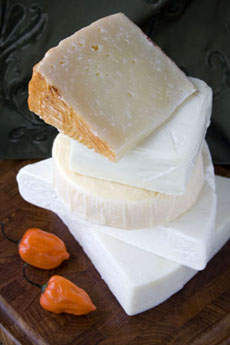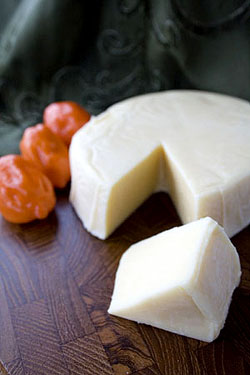

From top: Roth Käse GranQueso, Queso Blanco and Queso Quesadilla from El Viajero, Roth Käse Cotija and El Viajero Cotija. Photography by Claire Freierman | THE NIBBLE.
|
STEPHANIE ZONIS, Contributing Editor, focuses on good foods and the people who produce them.
|
|
March 2008
Updated December 2009
|
 |
Hispanic Cheese
Page 2: Melting Cheeses
- Click here to read other months’ Whey To Go columns
This is Page 2 of a five-page article. Click on the black links below to visit other pages.
How do Hispanic melting cheeses differ from the fresh cheeses we saw on the first page of this article? As the name implies, these cheeses are designed to melt when heated. Flavors and textures in these cheeses have a wider range than is seen in the fresh Hispanic cheeses.
But do you need a Hispanic cheese for Hispanic cuisine? Why not just use Cheddar? First, you’d miss out on the unique tastes of these wonderful Hispanic cheeses, but Hispanic melting cheeses have one additional advantage: They don’t separate into oil and solids when heated, so they make dishes seem more cheesy, without the greasiness.
- Asadero (ah-sah-DAY-roe) has a firm texture and is most often made in a log shape, then sold in slices. This is a smooth, yellow cheese, reminiscent of Provolone, with a bit of zest and tang. It’s often sliced or shredded to use for quesadillas or other sandwiches, and it’s ideal for nachos. As such, there are versions made with jalapeños and green chiles.
- Queso Manchego (KAY-so mon-CHAY-go, usually just referred to as Manchego) is one of Spain’s most famous cheeses. Traditionally made from the milk of just one breed of ewe, within the U.S. this cheese is most often made from low-fat cows’ milk. It’s a firm-textured cheese of a lovely golden hue; the taste is similar to an aged Monterey Jack, though slightly stronger. Manchego is a true “workhorse” cheese, in that it does almost everything well. It’s a natural paired with fruit and wine, or you can enjoy it by itself as a snack. By virtue of the fact that it’s included in this category, you know it’s also a good melting cheese.
- One of the best-loved cheeses in the Caribbean (especially Puerto Rico) is the orange-colored Queso de Papa (KAY-so day pah-PAH) With a firm and moist texture, this cheese is similar to Colby, although the flavor can be mild or tangy. It’s used both as an ingredient in cooked dishes and as a snack.
- Queso Quesadilla (KAY-so kay-sah-DEE-yah, also called Queso Chihuahua or Queso Menonita—see the challenge with multiple names for the same cheese?) is mild in flavor, with the smooth, almost buttery texture of a young Gouda. Legend has it that this cheese originated in a Mennonite community in Chihuahua, Mexico, hence the Queso Menonita name. This cheese can be made with whole or reduced-fat milk, and it works well for slicing or shredding—over salads, or shredded and melted over nachos (please, no Velveeta!), chili con carne and pizza. It is a popular filling, sliced thin and melted into quesadillas, chiles rellenos, chimichangas and enchiladas. Or, enjoy it as a table cheese. You can find versions made that include jalapeños.
|

Queso blanco holds its shape when cooking. Slice
and fry (breading optional). Cheese from El Viajero. |
- Queso Oaxaca (KAY-so wah-HA-kah) is like a slightly salty fresh mozzarella. In fact, the curds are usually heated, then stretched, exactly as is done for mozzarella. Cheese “ropes” are formed from the stretched curd, and the ropes are formed into balls for packaging. This cheese has its origins in the town of Oaxaca, as you might expect, and its distinctive shape is said to mimic the braided silver for which the town is famous. Queso Oaxaca is firm-textured and perfect for shredding, and it’s often shredded into dishes prior to cooking.
Continue to Page 3: Aged Cheeses
Go To The Article Index Above
Lifestyle Direct, Inc. All rights reserved. Images are the copyright of their respective owners.

|





